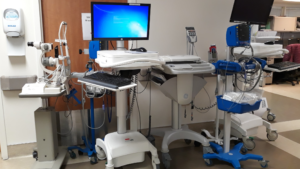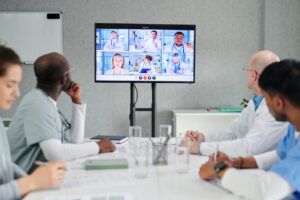
Wireless Medical Devices and Networks Critical During COVID-19

Before the COVID-19 pandemic, healthcare facilities knew that wireless medical devices improved patient care. These devices give healthcare professionals instant and easy access to patient data, improve care coordination, and allow patients more mobility during a hospital stay. All of that is still true and incredibly beneficial for patients and providers. During this pandemic though, wireless medical devices are providing even more important, life-saving benefits.
Enabling More Rapid Responses
Healthcare facilities have seen an increasing demand for cardiac monitors, respiratory monitors, hemodynamic monitors, and implantable devices. Many of these wireless devices provide automatic and instant alerts if a patient’s vitals drop or rise alarmingly. This allows providers to respond more rapidly to any problems.
These life-saving alerts also apply to any IoT-based devices used to monitor isolation units and pop-up clinics. For example, airborne infection isolation rooms, or negative pressure rooms, are critical for creating a barrier between patients with acute cases of COVID-19 and all other patients. Monitors in these rooms connect wirelessly to the network and send real-time alerts if the air pressure drops below set parameters.
Saving Valuable Hospital Space
Wireless devices provide medical professionals with real-time access to data. Providers can check-in on patients while on the go and review the data for multiple patients simultaneously on one screen. With this real-time data, providers can make a quicker diagnosis, reducing the time a patient spends in a facility. This can help slow the spread of the coronavirus, and save on valuable hospital space.
In addition, the past few years have seen a rise in at-home patient monitoring. Different IoT-based medical devices continuously monitor patient health and share all data with medical professionals, without requiring the patient to step foot in a hospital. Providers can access the data using a wirelessly connected device from anywhere in a healthcare facility, improving the ease of access and the speed of review.
Promoting Safe Distances
Wireless patient monitoring allows for the continuous monitoring of patients’ oxygen saturation levels and blood pressure – all from a safe distance. With these tools, medical professionals still receive vitally important data, data that helps keep patients safe and assists in treatment plan creation, but they can maintain a safe distance at the same time.
With electronic files and instant data sharing, providers also practice safe distancing by coordinating with other members of a care team through digital means. Digital communications improve care coordination, and are not adversely affected by social distancing or travel bans.
Monitoring and Managing Devices and the Network a Top Priority
These life-saving wireless devices and applications can number in the hundreds or thousands in a healthcare facility. Monitoring and managing these devices and reducing network downtime are critical priorities. IT departments need visibility into and control of these devices and the network, as well as a proactive approach to monitoring performance and ensuring the network is optimized and secure.
Currently, the FDA is being flexible in not enforcing the premarket review requirement for all modifications of existing devices – for example, if a manufacturer modified a ventilator and added a wireless capability for remote monitoring. In addition, new medical IoT devices and software programs are being designed to deal specifically with COVID-19 monitoring and triage. As these new devices start rapidly entering medical facilities, network visibility will be even more important. To add to the severity of the situation, Interpol released a warning that attempted ransomware attacks against hospitals and medical services have increased significantly. All this points to network monitoring and visibility being more vital than ever before.
Wyebot is the leader in AI-driven WiFi automation. Our award-winning, patented, Wireless Intelligence Platform (WIP) delivers complete network visibility, detailed real-time and historical insights, and actionable items automatically and proactively 24/7/365 to fully support healthcare networks.
Complete Network Visibility
WIP offers device fingerprinting, behavioral profiling, and device pattern recognition. Using these capabilities, every network connected device is given a unique identifier, or fingerprint. IT teams receive detailed insights into the capabilities of each device and updates if those capabilities change. With this solution, IT knows exactly how each device is utilizing the network, and what devices are connected to the network at all times.
Detailed Real-Time and Historical Insights
With its AI-driven WiFi automation, WIP delivers proactive 24/7 detection, notification, and mitigation of all possible and active issues. The automated solution improves network performance, reliability, and security as issues are identified and resolved before they cause any downtime. If IT are not on-location, WIP delivers the ability to remotely diagnose and troubleshoot issues from any location.
WIP automatically saves all past data and analytics. The platform creates graphs that display trends over time with data on APs, client distribution, and airtime and client utilization. Reviewing data from the past day, week, or month enables IT to know the exact status of the entire network’s health, and identify if and when upgrades and updates are necessary. This keeps all systems optimized now and into the future.
Improved Security
With complete and continuous visibility, real-time alerts, and historical data providing insights into network health and performance, WIP improves the security of a network, and minimizes any surprises. WIP’s synthetic network test suite also includes a security audit. The audit can be set to run manually or automatically, and WIP delivers instant alerts if any section of the audit fails.
Wireless medical devices deliver life-saving data in all hospitals, and wireless networks are the critical resource needed to enable those devices to work. Contact Wyebot today for any questions, and bring the Wireless Intelligence Platform to your facility.

